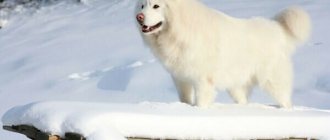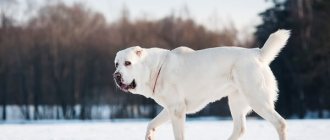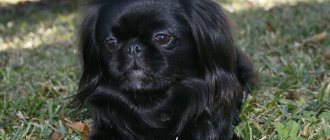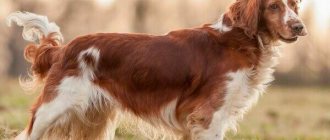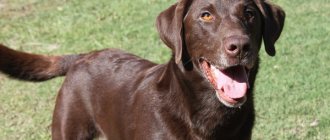The Labrador Retriever is a breed of dog that was originally bred as a hunting dog. Today, Labradors are widely used as guide dogs and companions. The animal originates from the island of Newfoundland, Canada.
White Labradors begin their history in the 19th century.
At that time, in order to obtain assistants in the hunting field, it was decided to cross breeds such as the small Newfoundland, the curly-haired retriever, the English foxhound and the setter. As a result, the Labrador Retriever appeared.
The first representatives were completely black, but as Labrador retrievers continued to be crossed with their brothers, white puppies appeared.
The animals were brought to Russia only in the 1990s, but almost immediately won the love of the inhabitants of this country.
Marriage or breed and what it looks like in the photo
The first breed standard was established back in 1887 by the English Kennel Club, which recognized only black color . However, at the beginning of the 20th century, fawn and chocolate colors became acceptable.
White Labrador Retrievers are never recognized by any kennel club, so this color is considered a defect.
Expert opinion
Kozhevin Semyon Kirillovich
Expert dog handler.
“The white Labrador retriever is no different from its black or chocolate counterparts; all its character traits fully comply with the breed standards. This animal is perfect for adults who will be able to spend a lot of time with it, because if the pet is left alone, then you can expect a disaster - furniture will be chewed, equipment will be damaged. The animal gets along well with children and will even tolerate being ridden, but this point should be controlled, since the pet is very emotional and may be offended by such an attitude, which will lead to illness. Often suffers from dysplasia.”
What affects color
Labradors remain a mystery to experts. It is quite difficult to guess the future colors of the offspring even if you know their pedigree. The puppy receives a pair of genes. A total of 9 combinations are formed. They determine the tone of a Labrador's coat.
- Pure black color is designated EEBB. With the inclusion of chocolate - EEBb. With fawn - EeBB. With two recessive genes - EeBb.
- Uniform fawn coat color - eeBB. With chocolate - eeBb. With weakened pigmentation - eebb.
- Brown - EEbb. With the fawn gene - Eebb.
In one litter, as a rule, there are puppies whose fur differs in different shades. There are cases where yellow or chocolate cubs are born from two black parents.
Personality Traits of a White Labrador
White Labrador Retrievers are very intelligent and quick-witted animals.
In this regard, they can even be compared with such well-known breeds as:
- beagle;
- fox terrier.
Labradors want to be useful, so they always listen to their owners. This is confirmed by numerous official ratings, where representatives of this breed occupy an honorable place in the top five in terms of intelligence and aptitude for training.
White Labrador Retrievers are very cheerful and playful, making them excellent companions for children . They are friendly towards strangers and other animals.
Despite the friendliness of white Labrador retrievers, they should not be housed in the same room as parrots or other birds, as this will trigger the dog’s hunting instinct.
Labrador retrievers are dogs created for living in a family; they literally become an integral part of it..
These animals cannot imagine their life without communication, but at the same time they subtly sense the mood of their owners, never getting bored. They are able to adapt not only to the mood of the owner, but even to his habits.
Due to the high intellectual abilities of the white Labrador retriever, it is quite possible to teach him the following actions:
- bring slippers;
- turn on the light;
- open or close doors.
Advantages and disadvantages
The Labrador Retriever has the following advantages::
- attractive appearance;
- friendliness, kindness to other animals and people;
- good receptivity of teams;
- ease of care and education;
- owner-oriented.
Among the disadvantages of the breed are the following::
- excessive kindness, which is why the animal cannot be a good guard;
- love of water, which is why the pet often runs through muddy puddles;
- likes to dig through garbage, often brings trophies to the owner in the form of dead rats and birds;
- can chew on absolutely any objects, which is why furniture often suffers;
- snore.
History of the origin of the breed
It is not known exactly where and how the Labrador Retriever breed originated. There are several versions:
- some consider the historical homeland of the breed to be the peninsula with the same name Labrador in Eastern Canada;
- the breed originated in the Northeast of America on the island of Newfoundland;
- the breed appeared as a result of mating dogs from Labrador and Newfoundland in the Canadian province;
- in the first generation of the breed there were exclusively black retrievers.
There is a theory that the name of the rock is related to the name of the stone labradorite, which is mined in Canada.
Scientists suggest that the dogs lived in the central province. In other countries, the breed appeared as a result of navigation that was then widespread in Newfoundland. Reliable sources say that sailors and travelers from the island brought aboriginal dogs to England.
It is known that at that time they were actively breeding two types of dogs - large shaggy ones (which were probably the ancestors of the Newfoundland), and small smooth-haired ones (which most likely became the founders of modern Labradors). Previously, dogs of both breeds had the same name - St. John's dogs. The Labrador was also dubbed the Little Newfoundland Dog at the time because it was smaller in size than the modern Newfoundland.
It is impossible to reliably determine the genetic relationship of two types of dogs or prove which breed arose first.
For the first time the breed was officially recognized in England. She was very popular there. Dogs were excellent helpers, so people used their strength and kindness to get nets out of the water, as well as weights and so on.
In the 19th century, English breeders carefully took care of the purity of the blood of their pets. However, by the middle of the century, interest in the breed had subsided a little. Goods stopped being brought from the island of Newfoundland. Only a narrow circle of owners had the opportunity to keep Labradors. These owners also tried to keep the dogs purebred.
Dimensions, weight and other distinctive features
White Labrador Retrievers have a number of features:
| Factor | Males | Bitches |
| Height (cm) | 56-57 | 54-56 |
| Weight, kg) | 27-40 | 27-35 |
| Body | Wide chest, rounded ribs, short wide loin. | |
| Head | Medium size. The transition from the forehead to the muzzle is clearly defined. | |
| Wool | Smooth, short, thick and even. | |
| Paws | Rounded, have well-developed pads | |
| Ears | Triangular, close to the head, light. | |
| Eyes | From hazel to brown. | |
Possible shades
White Labrador Retrievers come in several shades:
- White with black pigment . Occasionally, with age, a “golden coating” appears.
- Cream . There is a fairly light color; along the spine and ears there are slightly darkened areas of fur.
- Red Fox. Somewhat reminiscent of fox fur.
Life expectancy, and what diseases are they susceptible to?
The lifespan of a white Labrador retriever is from 10 to 14 years .
Over the course of life, problems with excess weight may arise, which lead to the development of a number of chronic diseases and shorten the pet’s life expectancy.
Among the common diseases in Labradors, the following are noted::
- dysplasia of the hip or elbow joint;
- osteochondrosis – the joint in the area of the knees, shoulders and elbows is not formed correctly;
- cataracts, retinal detachment and other eye diseases;
- hypothyroidism – deficiency of thyroid hormones;
- allergic reactions manifested by damage to the skin (eczema, dermatitis);
- ichthyosis (in this breed it occurs without damage to the immune system) - profuse dandruff;
- nasal parakeratosis – crusts and cracks on the nose.
Basic rules of care
Despite their short coat, Labrador Retrievers are regularly groomed using a rubber brush. The animal must be accustomed to this procedure from an early age, then the animal will simply adore it.
Thanks to this combing, the dog not only gets rid of excess hair, but also improves blood circulation and stimulates the growth of new hair..
Representatives of the breed are allowed to be bathed frequently. It is necessary to examine the animal’s ears and teeth every few weeks. If there is contamination, the ears are cleaned with a cotton swab previously soaked in hydrogen peroxide.
NOTE!
Once every 2-3 months, the pet’s teeth are cleaned to remove stones. If serious problems with gums or teeth are noticeable, then contact a veterinarian.
Caring for a Labrador Retriever also involves trimming its nails regularly. With frequent walks on asphalt, the claws wear down on their own.
For feeding , choose one of the options :
- store feed;
- natural food.
If the choice fell on natural food, then it is important to calculate its quantity, for example, for each kilogram of animal, 20 grams of meat are given at a time.
Products containing meat constitute 50% of the daily diet . Buckwheat, wheat and rice porridge are cooked for the animal.
Wonderful miracle, wonderful miracle
The miniature Labrador is the unfortunate result of mad breeding by scientists. Dear dog loving readers, never, under any circumstances, purchase a toy Labrador. Remember that by purchasing this dog, you are sponsoring unscrupulous breeders.
Where do such bold conclusions come from? This is because small Labradors do not exist as a separate breed. It's just that someone very smart realized that people like these dogs. Only they are very large, which means they are not always convenient for keeping in an apartment. This “someone” decided to reduce the size of the representatives of the breed. How? More on this in the next paragraph.
What do the puppies look like?
The appearance of Labrador Retriever puppies directly depends on their age.
For example, a 1-month-old puppy has the following characteristics :
- weight – from 3.4 to 3.8 kg;
- chest circumference – 37-38 cm;
- muzzle circumference – 17 cm;
- mouth girth – 9 cm;
- height at withers – from 23 to 23.5 cm;
- head circumference – 27-28 cm;
- muzzle length – from 3.5 to 4 cm.
In terms of its physique, it is a small copy of an already adult pet.
Feeding
Our expert claims that the best option for feeding a Labrador is super premium food. It has everything you need for a balanced diet.
During one meal, a dog eats about 200-300g. dry food (it all depends on the manufacturer of the food and the constitution of the individual). An adult animal eats twice a day, morning and evening. It turns out that he needs about 400-600 grams per day. dry food.
Some owners prefer to feed their pet from the table, but this is completely the wrong approach. There is an abundance of excellent balanced food on the market that will provide the dog with everything he needs without additional vitamins and minerals, the amount of which in the diet is extremely difficult to determine on your own.
The health and life expectancy of a Labrador directly depend on the quality of nutrition, as well as on the conditions of detention and genetics. On average, Labradors live 10-12 years. Sometimes these numbers reach 15 and even 18 years.
This is interesting! There is a myth that brown Labradors live longer than their counterparts of other colors. Alas, this is nothing more than long-outdated prejudices from the same series that a “black mouth” is a sign of anger.
What nickname to name a boy and a girl
Among the popular names for a white Labrador retriever boy are the following :
- Archie;
- Brook;
- Vico;
- Grego;
- Jam;
- Kevin;
- Leicester;
- Max;
- Nile;
- Oscar;
- Patrick;
- Roni;
- Sancho;
- Tito;
- Juan;
- Freddie;
- Shusan.
Popular nicknames for girls are::
- Athena;
- Beauty;
- Wendy;
- Grace;
- Dekla;
- Irma;
- Christie;
- Lana;
- Mimi;
- Nancy;
- Pixie;
- Chamomile;
- Sali;
- Tusya;
- Eileen;
- Floris;
- Shumka;
- Juno.
How to choose?
When choosing a white Labrador retriever puppy in a kennel, you need to pay attention to a number of points:
- It is better to purchase an animal from working lines. Thus, a person receives a guarantee of a stable psyche and good physical condition of the parents of the future pet.
- Availability of documents for timely vaccinations and absence of dysplasia in the puppy’s parents. Serious breeders test the condition of animals on the territory of European countries, where they travel with dogs to various exhibitions.
- If in a nursery Labradors are sitting in enclosures, then you should immediately turn around and leave, because these animals need constant communication, and such an attitude leads to mental disorders.
- When examining puppies, the bitch must be friendly and not interfere with this. At the beginning, a little barking is allowed, but the animal must quickly calm down, then it makes sense to talk about its normal mental state and choose puppies from this litter.
- From a good breeder you should expect a lot of questions, including not entirely decent ones, for example, “How much do you earn?” This indicates that the breeder cares about his pets and will not give them away to just anyone. But bad breeders, on the contrary, try in every possible way to praise their pets.
IMPORTANT!
Taking into account all these nuances, you can choose a physically healthy and mentally balanced puppy.
White Labrador retrievers can become true friends and faithful companions, the main thing is to devote at least a little time to them every day.
Price of a dog
The price of mini Labrador puppies depends on several factors, just like when buying any other puppies. It should be borne in mind that this species is very rare and finding a suitable breeder is extremely difficult. You cannot be sure that the puppy sold to you is a mini one; it is possible that by one year it will grow to a full-fledged adult of standard size. Therefore, you should not trust all sales advertisements that you come across on the Internet. The price cannot be less than twenty-five thousand.
